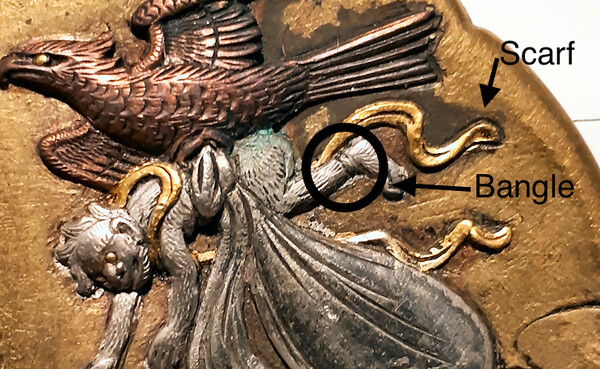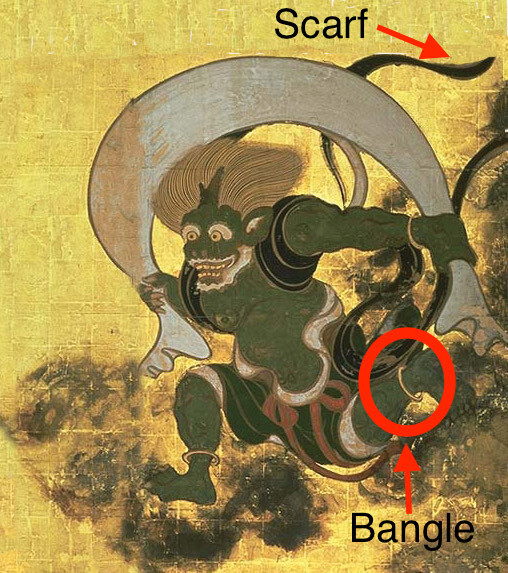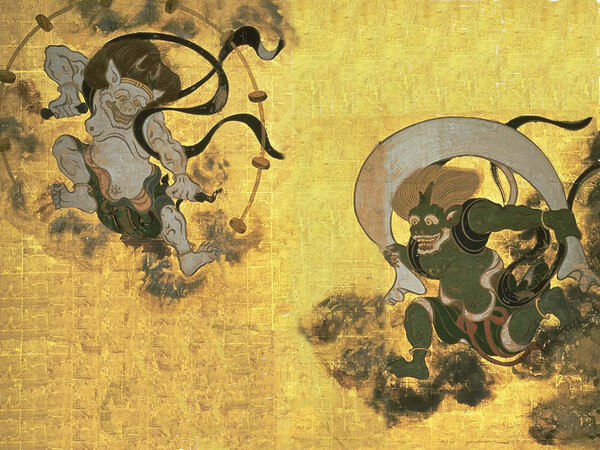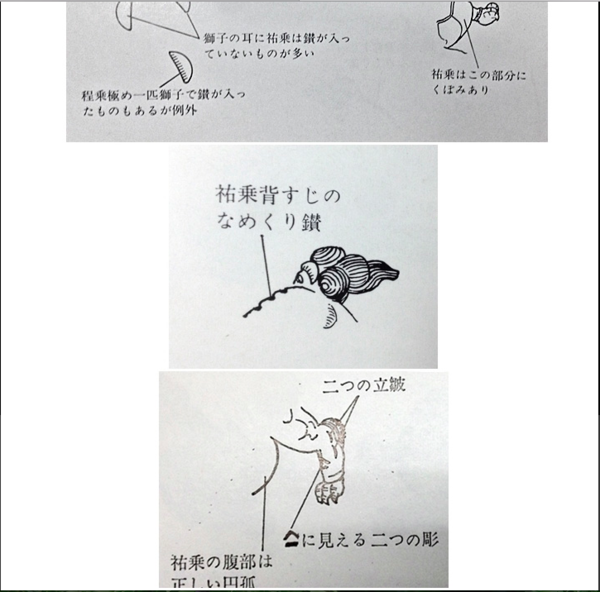-
Posts
858 -
Joined
-
Last visited
-
Days Won
7
Content Type
Profiles
Forums
Events
Store
Downloads
Gallery
Everything posted by Tanto54
-
Hi Ken, I agree with Grey. The fuchigashira and tsuba are not great but the menuki look decent. The tsukamaki is the kind that is usually done on better blades, so I think it is worth at least the asking price.
-
Hi Uwe, Yes, it is written up and pictured in the Naunton Collection Book by Joly. It says "1528. - F.K., copper, ishime, Fukurokujiu's large head on K., a boy on his shoulder; other child on F. with shishimai mask. Signed: Hamano Naoyuki." I have the book cheap if you want it....
-
Nice Frank - you should ask Darcy if you can use his pictures of these menuki (great color and closeups....)
-
Hi Chris, The humor idea is interesting; however, I think that it is more probable that your tsuba shows the defeat of Futen by a member of Buddha's army (i.e., the bird or Karura/Garuda). When discussing Fujin and Raijin (the wind and thunder gods), Japanese Legendary Lives by Gen-ichi Nishio says, "A legend of Chinese Buddhism says that the two gods [Fujin and Raijin] were originally evil demons who opposed Buddha. So Buddha ordered his heavenly army to capture the two demons. After a severe battle between demons and 33 gods, the two demons were finally captured. They have been working for heaven ever since." Other texts talk about a Karura (Japanese for Garuda) sitting on the top of Buddha's throne and being a soldier of Buddha and part of his army. The Karura is sometime depicted in Japanese art as half-man/half-bird; however, he is also sometimes simply depicted as an eagle. Therefore, I think that your tsuba shows Karura carrying Fujin back to Buddha after his defeat. I'd like to think that you tsuba might have been a part of a daisho and the other tsuba shows the defeat of Raijin (or perhaps that was on the matching fuchigashira). Maybe you should search Chinese Buddhist legends for more details.
-
Dear Grev, My pleasure. By the way, what is on the ura?
-
Dear Grev, This is Rinnasei (the Chinese Poet Lin Bu). The clues are the Chinese scholarly dress (fan and hair too), plum tree, crane and attendant. Rinnasei is said to have destroyed all his poems so that there would be no record of his writing. He is usually depicted with a plum tree (considered his wife) and one or two cranes (considered his child) and a young attendant.
-
PM sent
-
Does anyone know this Yahoo Japan Seller (ihhc3188) and how to contact them? Thanks and regards, George M.
-
Hi Steve, Ok, I hope this will convince you. Notice that the figure being carried by the bird in Chris' tsuba is also wearing a bangle (bracelet) on his foot (ankle). See picture below. As you know Fujin also wears a bangle (Monkeys do not). As pointed out before, Fujin also wears a loose, thin flowing scarf. Therefore, we have a bag, scarf and bangle on an "Oni-like" figure (Fujin is often described as looking like an Oni). And actually, Fujin was a demon before he was defeated and changed to the side of Buddha (and I suspect that this tsuba may depict something about Fujin's defeat).
-
Dear Steve, I'm positive that it is Fujin (also known as Futen) - see the famous painting below (he's the one on the right). Fujin has a scarf and a bag of wind (monkeys don't....) just like on the tsuba.
-
This is like watching a train wreck that I can't do anything about....
-
Hi Chris, Just to clarify, the figure being carried by the bird (hawk or an eagle) is Futen (also called Fujin). He looks a little like an Oni and can be identified by his "scarf" and wind bag. On the back of this tsuba, there is another figure (not pictured in your photo above) which I believe is a monkey.
-
Dear David, Just in case your wife isn't around and you have to tie something (or someone...) up.
-
Nice! I always enjoy them.
-
Dear Dwain, Like Chris said, some schools had designs that they followed pretty closely. Shishi with Botan (peony) is often Omori or Yokoya (i.e., Somin or Soyo). I'm not saying that your menuki are from those schools, I'm just saying that is a place to look when you see Shishi with Botan. Also, note the different marks on the fur. Goto is most often like the one that you posted from MFA or Uwe posted. Yours has swirls (like a pinwheel) that are usually not Goto.
-
Hi Dwain, There are a number of threads on how to identify Goto Shishi (search for something like "goto shishi"). Here's part of a book that someone else posted here a long time ago. I don't think that your Shishi have the standard Goto "secret" marks...
-
Dear Omar, That was exactly my point - you can find very nice menuki (much better than the ones you posted) for not much money. In addition, if you look carefully, you can find great quality (and even masterpieces) for several hundred if you are willing to take orphans or other kanagu (metal fittings like tobacco pouch claps, etc.).
-
Dear Steven, Any reason to believe the menuki that I posted are not "genuine"? Just like swords, you should buy quality not names... (by the way, if you have any that look like that, whether genuine or not, please sell them to me....)
-
Hi Omar, The pictures are too fuzzy to tell for sure, but I do believe that I see signs of modern casting. The "chisel marks" that you see on this piece could easily be part of the casting. Most importantly, the quality of this piece is really quite low. You can find much better (and faces with more charm and character) and still cheaply. For example, if you really just like fine work, but don't want to spend the money, you can get orphaned menuki. Some of the ones on the NMB are really very nice. Also, you can find other items like tobacco pouch claps that look like menuki and were made by the same guys who made menuki at around 20% of the price. These are not mine (just random menuki found on the Internet), but this is the level of quality you should be looking for IMO (either singly if you can't afford more, or by foregoing three low quality menuki to buy something much better).
-
Congratulations Peter! Hope to see this sword in person someday.
-

Gassan Sadatoshi Katana Modern November 2018
Tanto54 replied to a topic in General Nihonto Related Discussion
Congratulations!!! Gassan are awesome! -
Dear Chris, This is a Japanese Legend (Korea is mentioned in the Wiki article because supposedly the Tide Jewels were used by Japan to defeat Korea). There are many variations to the story. Basically, Ryujin is the Dragon King (who is the ruler of the seas) who owns the two Tide Jewels (one can make the tide ebb and the other makes the tide flow). In the story, Ryujin (who is represented wearing a dragon crown or with a dragon on his back) or his messenger Hakuja (who is a white serpent with the face of a man) gives the Tide Jewels to Hoori (his son-in-law). Hoori (also known as Hohodemi or Yama Sachi Hiko) is the mortal Hunter from the Tale of the Happy Hunter (about two brothers - one a fisherman and the other a hunter). The Hunter (Hoori) borrows his brother’s (Umi Sachi Hiko - the fisherman's) magic fish hook and then loses it. Hoori goes into the sea to find the fish hook and ends up staying for several years and marrying the Dragon King’s daughter. Later, when he decides to return to dry land, the Dragon King gives/sends him the two Tide Jewels. Some variations of the story includes Hachiman (the God of War) as an infant in the arms of Takenouchi no Sukune (usually represented with a long white beard and royal clothing) who is in a boat being presented the Tide Jewels from the Dragon King (or his messenger) who is in the water. In the case of your Tsuba, I believe that the guy in the water is Ryujin (the Dragon King), the guy in the boat is Takenouchi no Sukune and the fisherman on the backside is the fisherman brother (Umi Sachi Hiko).
-
Dear Chris, This is the story of the presentation of the Tide Jewels from Ryujin (Sea God with Dragon) to Hoori. The following is from Wikipedia: In Japanese mythology, the tide jewels – individually, the kanju (干珠, literally "(tide-)ebbing jewel") and manju (満珠, literally "(tide-)flowing jewel") – were magical gems that the Sea God used to control the tides. Classical Japanese history texts record an ancient myth that the ocean kami Watatsumi 海神 "sea god" or Ryūjin 龍神 "dragon god" presented the kanju and manju to his demigod son-in-law Hoori, and a later legend that Empress Jingū used the tide jewels to conquer Korea. Tide jewels interrelate Japanese dragons and wani sea-monsters, Indonesian mythology, the nyoi-ju 如意珠 "cintamani; wish-fulfilling jewel" in Japanese Buddhism, magic jewels of Nāga kings in Hindu mythology, and the pearl associations of Chinese dragons in Chinese mythology.










